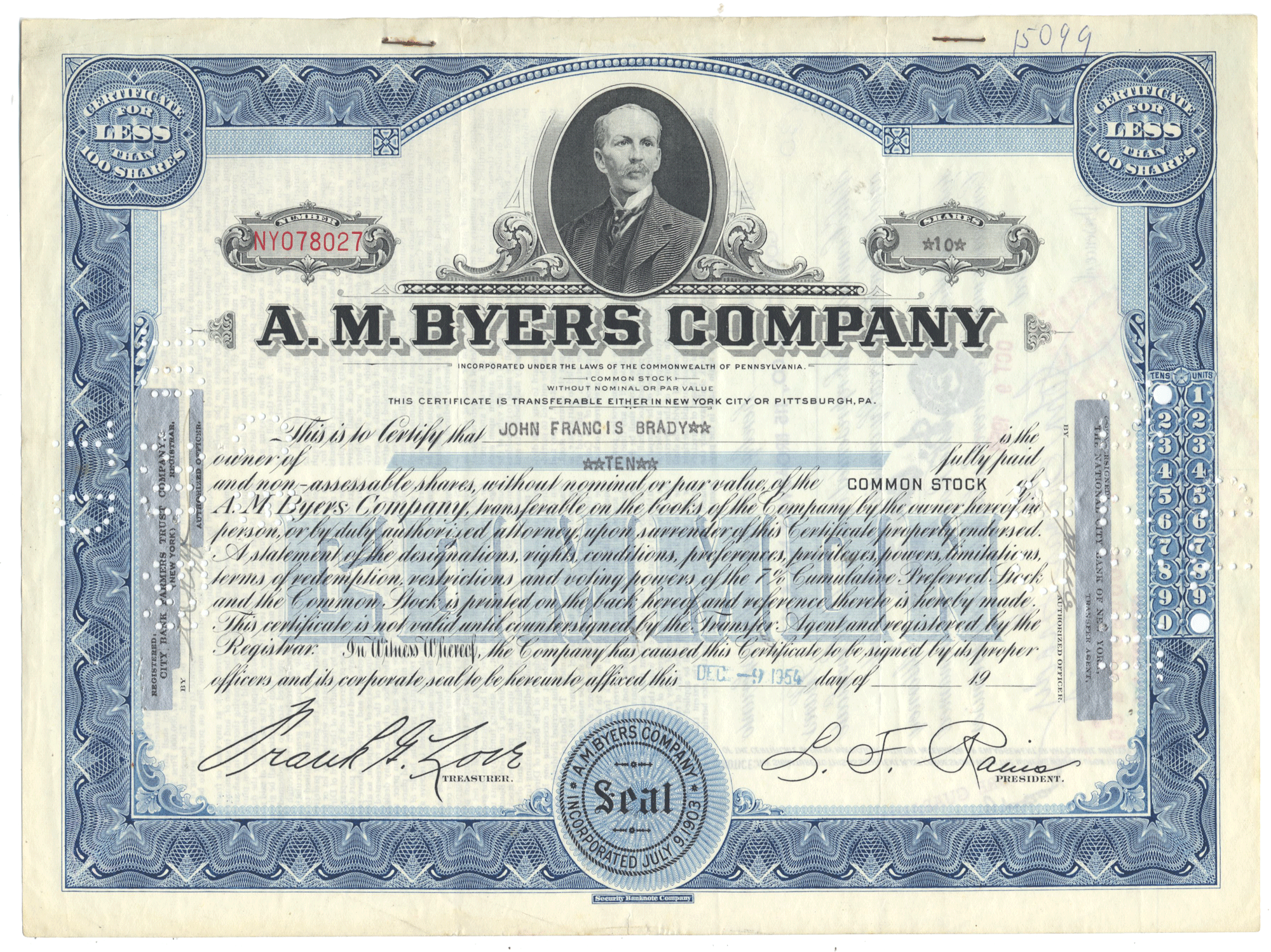
Boston and Albany Rail Road Company
- Guaranteed authentic document
- Orders over $75 ship FREE to U. S. addresses
Product Details



Boston and Albany Rail Road Company
Certificate Type
Capital Stock
Date Issued
January 28, 1892
Canceled
Yes
Printer
American Bank Note Company
Signatures
Hand signed
Approximate Size
11 1/2" (w) by 7 1/2" (h)
Additional Details
Please review scan for moisture discoloration in body
Historical Context

The Boston and Albany Railroad connected Boston, Massachusetts to Albany, New York, later becoming part of the New York Central Railroad system. Passenger service is still operated on the line by Amtrak (as part of their Lake Shore Limited), and the MBTA Commuter Rail system uses the section east of Worcester as their Framingham/Worcester Line.
History
The Boston and Worcester Railroad was chartered June 23, 1831 and construction began in August 1832. The line opened in sections — to Newton April 16, 1833; Wellesley July 3, 1833; Ashland September 20, 1833; Westborough November, 1834; and the full length to Worcester July 6, 1835.
The Western Railroad was chartered February 15, 1833 and incorporated March 15, 1833 to connect the B&W to the Hudson and Berkshire Railroad at the New York state line. Construction began in 1837, and the Eastern Division to the Connecticut River in Springfield opened on October 1, 1839. The Western Division, through the Berkshire Hills, opened in sections from both ends - from the state line to Pittsfield May 4, 1841, West Springfield to Chester May 24, 1841, Springfield to West Springfield (across the Connecticut River) July 4, 1841, Pittsfield to "Summit" August 9, 1841, and Chester to Summit September 13, 1841. On October 4, 1841 the first train ran along the full route.
The Castleton and West Stockbridge Railroad was incorporated in New York in 1834 as the New York part of the Western Railroad, and changed its name to the Albany and West Stockbridge Railroad (chartered May 5, 1836, organized May 20). Construction began four years later;and the line opened from Greenbush (east of Albany) to Chatham on December 21, 1841 and to the Massachusetts state line on September 12, 1842. It was leased to the Western Railroad for 50 years from November 11, 1841. This railroad replaced the Hudson and Berkshire Railroad east of Chatham, which was abandoned around 1860.
Two mergers, brought the three companies together, along with the Hudson and Boston Railroad into one company, known as the Boston and Albany Railroad. The New York Central and Hudson River Railroad leased the B&A for 99 years from July 1, 1900. This lease passed to the New York Central Railroad in 1914; throughout this, the B&A kept its own branding in the public eye. The NYC merged into Penn Central on February 1, 1968.
In 1899, the new South Station opened in Boston, a few blocks northeast of the old terminal. That terminal had been located on the west side of Utica Street, from Kneeland Street south to a bit past Harvard Street, now part of the South Bay Interchange. Even earlier, the terminal was in the block bounded by Kneeland Street, Beach Street, Albany Street (now Surface Artery) and Lincoln Street (which later became a freight house).
By the early part of the 20th century, commuter rail service was provided east of Worcester, with intercity rail continuing on west. The intercity trips were taken over by Amtrak on May 1, 1971, and on January 27, 1973 the MBTA acquired the line east of Framingham. Service beyond Framingham was discontinued October 27, 1975, as the state did not subsidize it. Conrail took over Penn Central on April 1, 1976. On September 26, 1994, some rush hour trains started to serve Worcester on Conrail trackage (which became CSX trackage on June 1, 1999), extending to other times beginning on December 14, 1996.
The Boston Subdivision of CSX retains rights to use certain MBTA-owned track.
Branches
The Grand Junction Railroad was chartered in 1847 as a re-incorpration of the 1846 Chelsea Branch Railroad, meant to connect the lines north and west of Boston. The first section, from East Boston to Somerville, opened in 1849, and the extension to the B&W in Allston opened in 1856. The Eastern Railroad leased the line from 1852 to 1866, using part of it as their new main line. In 1866 the B&W bought the line (keeping trackage rights for the Eastern).
The Brookline Branch split from the main line in the west part of Boston's Back Bay, running southwest for 1.55 mi to Brookline (the current location of Brookline Village station). It opened in 1847. In Summer 1852 the Charles River Branch Railroad extended the line to Newton Upper Falls; this would eventually become part of the New England Railroad, an alternate route to New York.
In 1882 the B&A bought part of the Charles River Branch, and in 1884 they built a line from Riverside to the branch, forming the Highland Branch, Newton Highlands Branch or "Newton Circuit". Service ended in 1958, and the MBTA Green Line "D" Branch light rail line started using the tracks in 1959.
The short 1.25 mile Newton Lower Falls Branch opened in 1847, splitting from the main line just west of Riverside to Newton Lower Falls. At some point it was realigned to split at Riverside.
The Saxonville Branch opened in 1846, running 3.87 miles from Natick to Saxonville.
The Framingham Branch opened in 1849, running 2.06 miles from Framingham to Framingham Centre. The Agricultural Branch Railroad was incorporated in 1847 and opened in 1855, continuing the branch to Northborough, and to Pratts Junction in 1866. It was leased by the B&W in 1853, but consolidated into the Boston, Clinton, Fitchburg and New Bedford Railroad in 1876 and leased to the Old Colony Railroad in 1879 after changing its name to the Boston, Clinton and Fitchburg Railroad in 1867. This company also used the Framingham Branch as part of its main line.
In 1847, the 11.97 mile Milford Branch, splitting at Framingham, opened. A connection was later made at Milford to the Milford and Woonsocket Railroad and Hopkinton Railway.
The 3.07 mile Millbury Branch opened in 1846 from a split at Millbury Junction on the Grafton/Millbury line to Millbury.
The Providence, Webster and Springfield Railroad was chartered in 1882, opened in 1884, and always leased to and operated by the B&A. The line formed a branch of the B&A from Webster Junction in Auburn to the Norwich and Worcester Railroad in Webster, with a short branch (East Village Branch) in Webster to East Village.
The Spencer Railroad opened and was leased to the B&A in 1879, as a short branch from South Spencer to Spencer. The B&A outright bought it in 1889.
The North Brookfield Railroad was chartered in 1874, incorporated in 1875 and opened in 1876, branching from the B&A in East Brookfield and running to North Brookfield. It was leased to the B&A from opening.
The Ware River Railroad was chartered in 1868, running from Palmer to the Cheshire Railroad in Winchendon. The first section, from Palmer to Gilbertville, opened two years later, and the rest in 1873. Until 1873 it was leased to and operated by the New London Northern Railroad; at that time the lease was transferred to the B&A, as a reorganization of the earlier company.
The Athol and Enfield Railroad and Springfield and North-Eastern Railroad were chartered in 1869, and succeeded by the Springfield, Athol and Northeastern Railroad in 1872, opening in 1873 as a branch from Athol Junction in Springfield to the Vermont and Massachusetts Railroad in Athol. The B&A bought the line in 1880. The majority of the line was later closed due to the formation of the Quabbin Reservoir.
The Chester and Becket Railroad was chartered in 1896 and opened in 1897 from Chester west to quarries in Becket. It was always operated by the B&A.
The Pittsfield and North Adams Railroad was incorporated in 1842 and opened in 1846, having been already leased to the Western Railroad. It ran from North Adams Junction in Pittsfield to North Adams, where it connected to the Troy and Greenfield Railroad.
The Hudson and Berkshire Railroad was chartered in 1828 to build a line from Hudson, New York to the Massachusetts state line. Construction began in 1835 and was completed in 1838. The company was leased to the Berkshire Railroad, along with the connecting West Stockbridge Railroad, in 1844, but was bought by the Western Railroad in 1854. The name was changed to the Hudson and Boston Railroad in 1855, and the part east of Chatham was abandoned five years later, as it was redundant with the newer Albany and West Stockbridge Railroad (part of the B&A main line). The rest of the line formed a cutoff between the New York Central and Hudson River Railroad towards New York City and the B&A.
The Post Road Branch or Selkirk Branch was originally built as part of the Hudson River Connecting Railroad, a southern bypass of the Albany area. It opened in 1924, and the part of it from the B&A at Post Road Crossing (the crossing of the Albany Post Road) to Schodack Junction on the east side of the Hudson River became the B&A Post Road Branch. The rest became the New York Central Railroad's Castleton Cut-Off.
Trivia
One Boston newspaper editor thought the original Boston to Albany rail project to be not only impractical but also “as useless as a railroad to the moon.”
Related Collections
Additional Information
Certificates carry no value on any of today's financial indexes and no transfer of ownership is implied. All items offered are collectible in nature only. So, you can frame them, but you can't cash them in!
All of our pieces are original - we do not sell reproductions. If you ever find out that one of our pieces is not authentic, you may return it for a full refund of the purchase price and any associated shipping charges.





